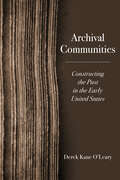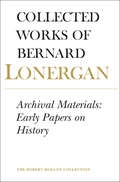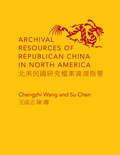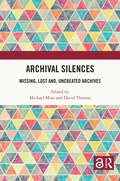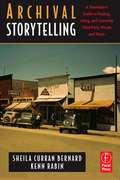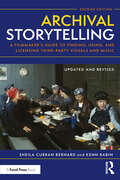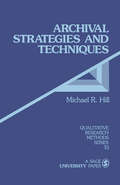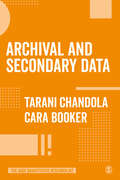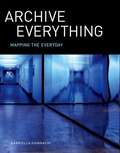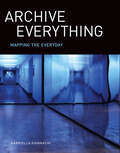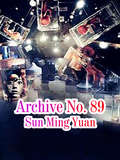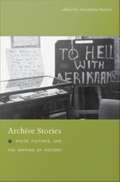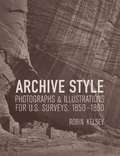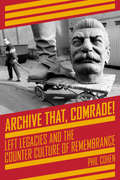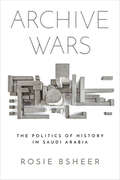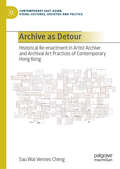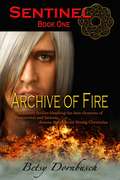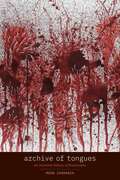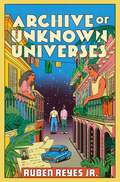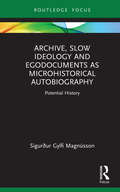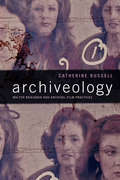- Table View
- List View
Archival Communities: Constructing the Past in the Early United States
by Derek Kane O'LearyThe story behind the creation of the first archives in the new United States Archives, the foundational resource for historical research, do not emerge from a vacuum. The records, documents, and data that make up the historian&’s quarry are never neutral but are themselves the product of historical forces and individual choices. What materials are included in the archive, and why? Whose voices are preserved for posterity, and whose are silenced? In recent years, scholars have increasingly made archives themselves the subject of investigation. With Archival Communities, Derek Kane O&’Leary takes up this crucial task for the era of the early United States, arguing that key components of America&’s archives emerged from within an Atlantic world of circulating scholars, evidence, practices, and ideas. As he shows, US archives—and the historical narratives spawned by the documents preserved within them—drew their initial materials and meaning from this international context. And while demonstrating the disproportionate imprint of powerful men, O&’Leary&’s Atlantic frame reveals a far broader community of people who engaged in early archival efforts on the national, state, and local levels, including women who influenced the act of collection and public perceptions of the young nation&’s historical record.
Archival Material: Early Papers on History, Volume 25 (Collected Works of Bernard Lonergan #25)
by Lonergan Research InstituteIn the mid- to late-1930s, while he was a student at the Gregorian University in Rome, Bernard Lonergan wrote a series of eight essays on the philosophy and theology of history. These essays foreshadow a number of the major themes in his life’s work. The significance of these essays is enormous, not only for an understanding of the later trajectory of Lonergan’s own work but also for the development of a contemporary systematic theology. In an important entry from 1965 in his archival papers, Lonergan wrote that the "mediated object" of systematics is Geschichte or the history that is lived and written about. In the same entry, he stated that the "doctrines" that this systematic theology would attempt to understand are focused on "redemption." The seeds of such a theology are planted in the current volume, where the formulae that are so pronounced in his later work first appear. Students of Lonergan’s work will find their understanding of his philosophy profoundly affected by the essays in this volume.
Archival Resources of Republican China in North America
by Chengzhi Wang Su ChenNorth America maintains the largest collection of archival materials relating to the Chinese Republican era (1911–1949) outside of China. Most of the archival materials are also unique, and the collections contain special materials supplementing historical records in China and Taiwan. In many cases, North America's holdings represent the best and only public access to the tumultuous Republican government and society of the first half of the twentieth century. <P><P>An essential guide for researchers and students of Republican China, this volume, presented in both English and Chinese, covers personal papers, correspondences, memoirs, diaries, photographs, moving images, and other materials held at academic and research institutions across the United States and Canada. It includes concise descriptions of the people, organizations, and events connected to each entry and notes when certain collections are closely related and when materials are digitized for online access. The book corrects common errors associated with the library records of many archives and updates or completes information on the objects of these records. More than a straightforward itemization, this book adds significant depth to any research on the history and global import of China's modern development.
Archival Silences: Missing, Lost and, Uncreated Archives
by David Thomas Michael MossArchival Silences demonstrates emphatically that archival absences exist all over the globe. The book questions whether benign ‘silence’ is an appropriate label for the variety of destructions, concealment and absences that can be identified within archival collections. Including contributions from archivists and scholars working around the world, this truly international collection examines archives in Australia, Brazil, Denmark, England, India, Iceland, Jamaica, Malawi, The Philippines, Scotland, Turkey and the United States. Making a clear link between autocratic regimes and the failure to record often horrendous crimes against humanity, the volume demonstrates that the failure of governments to create records, or to allow access to records, appears to be universal. Arguing that this helps to establish a hegemonic narrative that excludes the ‘other’, this book showcases the actions historians and archivists have taken to ensure that gaps in archives are filled. Yet the book also claims that silences in archives are inevitable and argues not only that recordkeeping should be mandated by international courts and bodies, but that we need to develop other ways of reading archives broadly conceived to compensate for absences. Archival Silences addresses fundamental issues of access to the written record around the world. It is directed at those with a concern for social justice, particularly scholars and students of archival studies, history, sociology, international relations, international law, business administration and information science.
Archival Storytelling: A Filmmaker's Guide To Finding, Using, And Licensing Third-party Visuals And Music
by Sheila Curran Bernard Kenn RabinArchival Storytelling is an essential, pragmatic guide to one of the most challenging issues facing filmmakers today: the use of images and music that belong to someone else. Where do producers go for affordable stills and footage? How do filmmakers evaluate the historical value of archival materials? What do vérité producers need to know when documenting a world filled with rights-protected images and sounds? How do filmmakers protect their own creative efforts from infringement?Filled with advice and insight from filmmakers, archivists, film researchers, music supervisors, intellectual property experts, insurance executives and others, Archival Storytelling defines key terms-copyright, fair use, public domain, orphan works and more-and challenges filmmakers to become not only archival users but also archival and copyright activists, ensuring their ongoing ability as creators to draw on the cultural materials that surround them.Features conversations with industry leaders including Patricia Aufderheide, Hubert Best, Peter Jaszi, Jan Krawitz, Lawrence Lessig, Stanley Nelson, Rick Prelinger, Geoffrey C. Ward and many others.
Archival Storytelling: A Filmmaker’s Guide to Finding, Using, and Licensing Third-Party Visuals and Music
by Sheila Curran Bernard Kenn RabinFully revised and updated, Archival Storytelling second edition is a timely, pragmatic look at the use of audiovisual materials available to filmmakers and scholars, from the earliest photographs of the 19th century to the work of media makers today. Whether you’re a top Hollywood filmmaker or a first-time documentarian, at some point you are going to want to find, use, and license third-party materials—images, audio, or music that you yourself did not create—to use them in your work. This book explains what’s involved in researching and licensing visuals and music, and exactly what media makers need to know when filming in a world crowded with rights-protected images and sounds. Filled with insights from filmmakers, archivists, and intellectual property experts, this second edition defines key terms such as copyright, fair use, public domain, and orphan works. It guides readers through the complex archival process and challenges them to become not only archival users but also archival and copyright activists. This book is an essential resource for both students and professionals, from seasoned filmmakers to those creating their first projects, offering practical advice for how to effectively and ethically draw on the wealth of cultural materials that surround us.
Archival Strategies and Techniques (Qualitative Research Methods #31)
by Dr Michael Ray HillHistorical and biographical work is becoming a more common type of qualitative research done by social scientists and usually requires the extensive use of formal archives housed in universities, governments, museums and other institutions. This practical and concise book provides an introduction for the novice on conducting archival research and covers such topics as contacting and preparing to work in archives, the protocol of using archives, and ways of organizing and referencing the useful data from the archive.
Archival Studies, M. A. Final History Paper-VI, SDE, AU
by School Of Distance EducationThis is the prescribed text book for students pursuing MA Final History at School Of Distance Education, Andhra University for the subject History of Archival Studies
Archival and Secondary Data (The SAGE Quantitative Research Kit)
by Tarani Chandola Cara BookerData archives provide rich and expansive sources of information for researchers. This book highlights the utility of secondary data analyses whilst showing you how to select the right datasets for your study, and in turn get the most out of your research. Topics include: · Generating your research question · Selecting appropriate datasets and variables · Examining univariate, bivariate and multivariate associations · Visualisng your data with tables and graphs Part of The SAGE Quantitative Research Kit, this book boosts students with know-how and confidence, to help them succeed on their quantitative research journey.
Archival and Secondary Data (The SAGE Quantitative Research Kit)
by Tarani Chandola Cara BookerData archives provide rich and expansive sources of information for researchers. This book highlights the utility of secondary data analyses whilst showing you how to select the right datasets for your study, and in turn get the most out of your research. Topics include: · Generating your research question · Selecting appropriate datasets and variables · Examining univariate, bivariate and multivariate associations · Visualisng your data with tables and graphs Part of The SAGE Quantitative Research Kit, this book boosts students with know-how and confidence, to help them succeed on their quantitative research journey.
Archive Everything: Mapping the Everyday
by Gabriella GiannachiIn Archive Everything, Gabriella Giannachi traces the evolution of the archive into the apparatus through which we map the everyday. The archive, traditionally a body of documents or a site for the preservation of documents, changed over the centuries to encompass, often concurrently, a broad but interrelated number of practices not traditionally considered as archival. Archives now consist of not only documents and sites but also artworks, installations, museums, social media platforms, and mediated and mixed reality environments. Giannachi tracks the evolution of these diverse archival practices across the centuries. Archives today offer a multiplicity of viewing platforms to replay the past, capture the present, and map our presence. Giannachi uses archaeological practices to explore all the layers of the archive, analyzing Lynn Hershman Leeson's !Women Art Revolution project, a digital archive of feminist artists. She considers the archive as a memory laboratory, with case studies that include visitors' encounters with archival materials in the Jewish Museum in Berlin. She discusses the importance of participatory archiving, examining the "multimedia roadshow" Digital Diaspora Family Reunion as an example. She explores the use of the archive in works that express the relationship between ourselves and our environment, citing Andy Warhol and Ant Farm, among others. And she looks at the transmission of the archive through the body in performance, bioart, and database artworks, closing with a detailed analysis of Lynn Hershman Leeson's Infinity Engine.
Archive Everything: Mapping the Everyday
by Gabriella GiannachiHow the archive evolved to include new technologies, practices, and media, and how it became the apparatus through which we map the everyday.In Archive Everything, Gabriella Giannachi traces the evolution of the archive into the apparatus through which we map the everyday. The archive, traditionally a body of documents or a site for the preservation of documents, changed over the centuries to encompass, often concurrently, a broad but interrelated number of practices not traditionally considered as archival. Archives now consist of not only documents and sites but also artworks, installations, museums, social media platforms, and mediated and mixed reality environments. Giannachi tracks the evolution of these diverse archival practices across the centuries. Archives today offer a multiplicity of viewing platforms to replay the past, capture the present, and map our presence. Giannachi uses archaeological practices to explore all the layers of the archive, analyzing Lynn Hershman Leeson's !Women Art Revolution project, a digital archive of feminist artists. She considers the archive as a memory laboratory, with case studies that include visitors' encounters with archival materials in the Jewish Museum in Berlin. She discusses the importance of participatory archiving, examining the “multimedia roadshow” Digital Diaspora Family Reunion as an example. She explores the use of the archive in works that express the relationship between ourselves and our environment, citing Andy Warhol and Ant Farm, among others. And she looks at the transmission of the archive through the body in performance, bioart, and database artworks, closing with a detailed analysis of Lynn Hershman Leeson's Infinity Engine.
Archive No. 89: Volume 1 (Volume 1 #1)
by Sun MingYuanA woman's head soaked in formalin was accidentally found by Tang Doberman, the head of the police officer. As a police officer, he intended to investigate the matter, and as the police officers continued to obstruct him, he fell deeper and deeper into the darkness was spreading. How could he reverse the shocking murder caused by a head? [Previous Chapter] [Table of Contents] [Next Chapter] Reader: 189081841
Archive No. 89: Volume 2 (Volume 2 #2)
by Sun MingYuanA woman's head soaked in formalin was accidentally found by Tang Doberman, the head of the police officer. As a police officer, he intended to investigate the matter, and as the police officers continued to obstruct him, he fell deeper and deeper into the darkness was spreading. How could he reverse the shocking murder caused by a head?
Archive No. 89: Volume 3 (Volume 3 #3)
by Sun MingYuanA woman's head soaked in formalin was accidentally found by Tang Doberman, the head of the police officer. As a police officer, he intended to investigate the matter, and as the police officers continued to obstruct him, he fell deeper and deeper into the darkness was spreading. How could he reverse the shocking murder caused by a head?
Archive Stories: Facts, Fictions, and the Writing of History
by Antoinette BurtonDespite the importance of archives to the profession of history, there is very little written about actual encounters with them--about the effect that the researcher's race, gender, or class may have on her experience within them or about the impact that archival surveillance, architecture, or bureaucracy might have on the histories that are ultimately written. This provocative collection initiates a vital conversation about how archives around the world are constructed, policed, manipulated, and experienced. It challenges the claims to objectivity associated with the traditional archive by telling stories that illuminate its power to shape the narratives that are "found" there. Archive Stories brings together ethnographies of the archival world, most of which are written by historians. Some contributors recount their own experiences. One offers a moving reflection on how the relative wealth and prestige of Western researchers can gain them entry to collections such as Uzbekistan's newly formed Central State Archive, which severely limits the access of Uzbek researchers. Others explore the genealogies of specific archives, from one of the most influential archival institutions in the modern West, the Archives nationales in Paris, to the significant archives of the Bakunin family in Russia, which were saved largely through the efforts of one family member. Still others explore the impact of current events on the analysis of particular archives. A contributor tells of researching the 1976 Soweto riots in the politically charged atmosphere of the early 1990s, just as apartheid in South Africa was coming to an end. A number of the essays question what counts as an archive--and what counts as history--as they consider oral histories, cyberspace, fiction, and plans for streets and buildings that were never built, for histories that never materialized. Contributors. Tony Ballantyne, Marilyn Booth, Antoinette Burton, Ann Curthoys, Peter Fritzsche, Durba Ghosh, Laura Mayhall, Jennifer S. Milligan, Kathryn J. Oberdeck, Adele Perry, Helena Pohlandt-McCormick, John Randolph, Craig Robertson, Horacio N. Roque Ramrez, Jeff Sahadeo, Rene Sentilles
Archive Style: Photographs and Illustrations for U.S. Surveys, 1850-1890
by Robin KelseyThis imaginative study of American visual culture reveals how the political predicaments of a few small bureaucracies once fostered pictures of an extraordinary style. U.S. geographical and geological surveys of the late nineteenth century produced photographs and drawings of topography, American Indians, geologic features, botanical specimens, and specialists at work in the field. Some of these pictures have long been celebrated for their anticipation of a modernist aesthetic, but Robin Kelsey, in this abundantly illustrated volume, traces their modernistic qualities to archival ingenuity. The technical and promotional needs of surveys, Kelsey argues, fostered the emergence of a taut, graphic pictorial style that imitated the informational clarity of diagrams and maps. As this book demonstrates, these pictures became sites of struggle as well as innovation when three brilliant survey artists and photographers subtly resisted the programs they were hired to serve. Discovering a politics of style behind the modernist look of survey pictures, Kelsey offers a fresh interpretation of canonical western expedition photographs by Timothy H. O'Sullivan and introduces two exceptional but largely forgotten sets of pictures: views of the U.S.-Mexico boundary from the 1850s by Arthur Scott and photographs of the Charleston earthquake of 1886 by C. C. Jones.
Archive That, Comrade!: Left Legacies and the Counter Culture of Remembrance (KAIROS)
by Phil CohenAfter a brief introduction that sets the contemporary scene of "archive fever," this book considers the political legacy of 1960s counterculture for what it reveals about the process of commemoration. How far can the archive serve as a platform for dialogue and debate between different generations of activists in a culture that fetishizes the evanescent present, practices a profound amnesia about its counterfactual past, and forecloses the sociological imagination of an alternative future? Can the Left establish its own autonomous model of commemoration?
Archive Wars: The Politics of History in Saudi Arabia (Stanford Studies in Middle Eastern and Islamic Societies and Cultures)
by Rosie BsheerThe production of history is premised on the selective erasure of certain pasts and the artifacts that stand witness to them. From the elision of archival documents to the demolition of sacred and secular spaces, each act of destruction is also an act of state building. Following the 1991 Gulf War, political elites in Saudi Arabia pursued these dual projects of historical commemoration and state formation with greater fervor to enforce their postwar vision for state, nation, and economy. Seeing Islamist movements as the leading threat to state power, they sought to de-center religion from educational, cultural, and spatial policies. With this book, Rosie Bsheer explores the increasing secularization of the postwar Saudi state and how it manifested in assembling a national archive and reordering urban space in Riyadh and Mecca. The elites' project was rife with ironies: in Riyadh, they employed world-renowned experts to fashion an imagined history, while at the same time in Mecca they were overseeing the obliteration of a thousand-year-old topography and its replacement with commercial megaprojects. Archive Wars shows how the Saudi state's response to the challenges of the Gulf War served to historicize a national space, territorialize a national history, and ultimately refract both through new modes of capital accumulation.
Archive as Detour: Historical Re-enactment in Artist Archive and Archival Art Practices of Contemporary Hong Kong (Contemporary East Asian Visual Cultures, Societies and Politics)
by Sau Wai Vennes ChengThe book brings a new approach to see the art history of Hong Kong as a historical mediator and offers alternative perspective to discern the current hype of archive research and archival art practices, which informs the commitment in the constant production of socio-political meanings through arts. The book addresses the current social-political crises of Hong Kong by connecting art, memory, history, and political participation together through the site of archive and contextualises in both local and global perspectives, it also focuses on the artist archive, namely Ha Bik Chuen Archive, and archival art practices of contemporary Hong Kong, particularly in the social and political unrests, however, it ripples resonance and reflection not only in the local context but also to the region. The book is intended to the readers who are interested in both representational and interpretational nature of art and searching for alternatives means to perceive histories.
Archive of Fire
by Betsy DornbuschTwins Aidan and Kaelin didn't realize until they got to university that most guys don't learn five ways to kill a man by the age of fourteen. Still, since their estranged father descends from the demon Asmodai, it's probably worth knowing how to defend themselves. But as years pass and threat never materializes, the twins suppose their mom is just paranoid - until she disappears. Their father tells them Asmodai has taken possession of their mother in order to infiltrate Sentinel, a treacherous coalition of demidemon rebels determined to protect humankind from the demon legions. The twins form a grudging alliance with Sentinel to rescue her, but when Asmodai murders their father to incite war, Sentinel starts to implode and Aidan and Kaelin must battle an enemy who wears their mother's face.
Archive of Tongues: An Intimate History of Brownness
by Moon CharaniaIn Archive of Tongues Moon Charania explores feminine dispossession and the brown diaspora through a reflection on the life of her mother. Drawing on her mother’s memories and stories of migration, violence, sexuality, queerness, domesticity, and the intimate economies of everyday life, Charania conceptualizes her mother’s tongue as an object of theory and an archive of brown intimate life. By presenting a mode of storytelling that is sensual and melancholic, piercing and sharp, Charania recovers otherwise silenced modes of brown mothers’ survival, disobedience, and meaning making that are often only lived out in invisible, intimate spaces, and too often disappear into them. In narrating her mother’s tongue as both metaphor for and material reservoir of other ways of knowing, Charania gestures to the afflictions, limits, and failures of feminist, queer, and postcolonial scholarly interrogations and the consequences of closing the archive of the brown mother.
Archive of Unknown Universes: A Novel
by Ruben Reyes Jr.From the critically acclaimed author of There Is a Rio Grande in Heaven, a piercing debut novel following two families in alternative timelines of the Salvadoran civil war—a stunning exploration of the mechanisms of fate, the gravity of the past, and the endurance of love."Beautiful." —LA Times, A Must-Read Book for Summer "Luminous." —People, A Best Book of July Cambridge, 2018. Ana and Luis’s relationship is on the rocks, despite their many similarities, including their mothers who both fled El Salvador during the war. In her search for answers, and against her best judgement, Ana uses The Defractor, an experimental device that allows users to peek into alternate versions of their lives. What she sees leads her and Luis on a quest through Havana and San Salvador to uncover the family histories they are desperate to know, eager to learn if what might have been could fix what is.Havana, 1978. The Salvadoran war is brewing, and Neto, a young revolutionary with a knack for forging government papers, meets Rafael at a meeting for the People's Revolutionary Army. The two form an intense and forbidden love, shedding their fake names and revealing themselves to each other inside the covert world of their activism. When their work separates them, they begin to exchange weekly letters, but soon, as the devastating war rages on, forces beyond their control threaten to pull them apart forever.Ruben Reyes Jr.’s debut novel is an epic, genre-bending journey through inverted worlds—one where war ends with a peace treaty, and one where it ends with a decisive victory by the Salvadoran government. What unfolds is a stunning story of displacement and belonging, of loss and love. It’s both a daring imagining of what might have been and a powerful reckoning of our past.
Archive, Slow Ideology and Egodocuments as Microhistorical Autobiography: Potential History
by Sigurður Gylfi MagnússonThis book aims to demonstrate how scholars in recent times have been utilizing egodocuments from various angles and providing an opening for the multivocality of the sources to be fully appreciated. The first part of the book is concerned with the significance of egodocuments, both for the individual him/herself who creates such documents, and also for the other, who receives them. The author approaches the subject on the basis of his own personal experience, and goes on to discuss the importance of such documents for the academic world, emphasizing more general questions and issues within the fields of historiography, philosophy of history, microhistory, and memory studies. The second part of the book is based upon a photographic collection – an archive – that belonged to the author’s grandfather, who over decades accumulated photographs of vagabonds and outsiders. This part seeks to explore what kind of knowledge can be applied when a single source – an archive, document, letter, illustration, etc. – is examined, and whether the knowledge derived may not be quite as good in its own context as in the broader perspective.
Archiveology: Walter Benjamin and Archival Film Practices (a Camera Obscura Book)
by Catherine RussellIn Archiveology Catherine Russell uses the work of Walter Benjamin to explore how the practice of archiveology—the reuse, recycling, appropriation, and borrowing of archival sounds and images by filmmakers—provides ways to imagine the past and the future. Noting how the film archive does not function simply as a place where moving images are preserved, Russell examines a range of films alongside Benjamin's conceptions of memory, document, excavation, and historiography. She shows how city films such as Nicole Védrès's Paris 1900 (1947) and Thom Andersen's Los Angeles Plays Itself (2003) reconstruct notions of urban life and uses Christian Marclay's The Clock (2010) to draw parallels between critical cinephilia and Benjamin's theory of the phantasmagoria. Russell also discusses practices of collecting in archiveological film and rereads films by Joseph Cornell and Rania Stephan to explore an archival practice that dislocates and relocates the female image in film. In so doing, she not only shows how Benjamin's work is as relevant to film theory as ever; she shows how archiveology can awaken artists and audiences to critical forms of history and memory.
